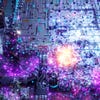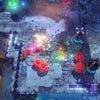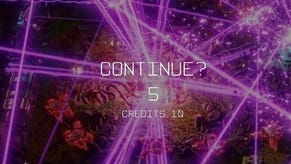Nex Machina's high-tech twin-stick magic tested on PC
Digital Foundry checks out the evolved Resogun engine operating at full 4K.
A collaboration between arcade genius Eugene Jarvis and developer Housemarque, Nex Machina takes the voxel-based technology pioneered in the brilliant Resogun and significantly enhances it to deliver an action-packed experience filled with destruction. Backing away from the 30fps approach taken in its prior twin-stick shooter, Alienation, Nex Machina doubles down on 60Hz, taking Resogun's technology to the next level. It's looking great, something we can comfortably say having spent the last few days playing a beta version of the PC version.
Of course, we've looking at early code here, so it's impossible to draw any conclusions with regards to performance and final graphical quality - but we couldn't resist breaking out the GTX 1080 Ti and running at this at full native 4K. But we should stress again just how early this code is: display options are limited to a v-sync checkbox and the ability to select a chosen resolution via a small dialogue box that appears before the game boots. Our set-up runs the current beta mostly at 60fps, our enjoyment only hampered by some small stutters that seem to derive from unoptimised CPU performance - on an i5, Nex Machina currently favours one core heavily over any others, something we expect to see addressed when the game launch
With that in mind, the current code still provides a very promising experience that shows off the new engine upgrades and gameplay features. The arcade shooting is superb, with the effects work and attention to detail here really looking quite spectacular - especially at 4K.
At its core Nex Machina uses an enhanced version of the voxel technology that powers Resogun, but the system is expanded upon to provide more variety and detail in terms of destructible environments and effects work. Whereas Resogun used voxels almost exclusively, Nex Machina combines this technology with traditional geometry-based 3D to better flesh out details that voxels alone would not be able to easily reproduce. This allows for more organic surfaces across the two levels on show in the beta, compared to the angular industrial locations in Resogun, allowing for more organic environments, but still based on a highly stylised aesthetic.
Nex Machina is all about blowing up stuff, and there's never a lack of enemies or objects to blast into pieces through the stages present in the beta, resulting in lots of colourful particles and some impressive physics-based destruction. It's absolute carnage, with the experience playing out like a turbo-charged Robotron crossed with a bullet-hell shooter. This is an experience that Housemarque specialise in, and the implementation here is their most accomplished yet.
Much of the environment is destructible in some way, with intense shootouts causing surrounding structures to crumble and break apart into a flurry of debris upon impact. Key objects can be completely obliterated, while the rest of the scenery takes chip damage on surfaces where it makes sense for this to happen, helping to make the frantic shooting feel even more immersive. The voxel-based technology is fundamental in delivering this constant spectacle throughout the game, and it works well.
To achieve this, Housemarque use a volumetric rendering technique called Signed Distance Fields, which blends both geometry and voxel elements together in a way that makes complex transitions between 3D meshes and voxels appear smooth. So, as structures crumble the switch from larger and more detailed geometric debris to voxel particles all looks rather natural when mayhem ensues. The same technique is also used to allow for enemies to explode into pieces, littering the screen with square particles.
What's impressive here is that each voxel particle features its own physics properties and can interact with the environment and other particles in a realistic manner, lending a sense of authenticity when objects explode. Every particle casts its own shadow and reacts to light sources across the environment too, allowing for these elements to fit seamlessly in with the rest of the scene. Another cool touch is the way explosions send large voxelised shockwaves across the screen, with the force rippling through the environment, causing the geometry to shift and distort as this happens. These changes occur in real-time, with surface geometry, lighting, materials, and shadows all updated as the effect is taking place. Just like Alienation, use of physically-based rendering ensures that all surfaces react realistically under various lighting conditions.
The level of detail here is very impressive considering the hundreds of particles on screen and how these interact with the complex voxel-based environments. Nex Machina may be a simple arcade shooter, but the complex nature of the destruction system delivers a level of visual flare that infuses the action with a sense of realism. While more expansive triple-A titles may feature greater scope and more lifelike visuals, the simple nature of Nex Machina allows for the developers to incorporate advanced effects work that would be impossible to see on far more complex titles, and the results are often striking.
Nex Machina looks great in terms of the effects work and general visual design, although in terms of image quality at 4K the game appears softer than expected, with the presentation taking on a very smooth look with some noticeable blurring present across the scene. This may be part of the aesthetic the developer is aiming for, or some aspect of the beta that will be improved, but it'll be interesting to see how the final game compares. Housemarque did confirm native 4K rendering to us, noting that the soft blur comes from the firm's temporal anti-aliasing solution.
And speaking of comparisons, we're also looking forward to seeing the PlayStation 4 versions of the game. A Pro-based resolution upgrade over base hardware will be almost certainly on the cards, and bearing in mind how much work Housemarque put into its Resogun 4K mode, we're hoping to see that extensive effort pay off or Nex Machina too.
From what we've seen so far, core visual elements on PC look very close to what we saw from the PS4 version at the PlayStation Experience, with the same core assets and effects work in play in the beta. Housemarque has been busy though, refining the experience since then. There are some small presentational changes in a few areas, such as camera angle placement in a couple of locations. As the game is still in development this doesn't come as a surprise, but it's interesting to see how a few subtle tweaks help to improve the natural flow of play.
As things stand, Nex Machina is shaping up to be one of the most addictive shooters Housemarque has created so far, blending ideas from the likes of Robotron, Resogun, and The Chaos Engine into a visually striking and highly entertaining package. And crucially, it signals a return to the signature 60fps gameplay that helped to elevate Super Stardust HD and Resogun into genuine PlayStation classics. There's no firm release date for Nex Machina right now, but we're really looking forward to playing more.














